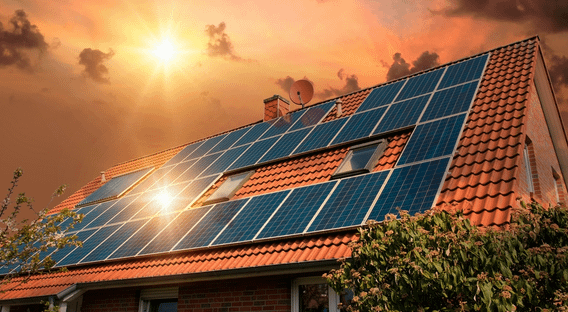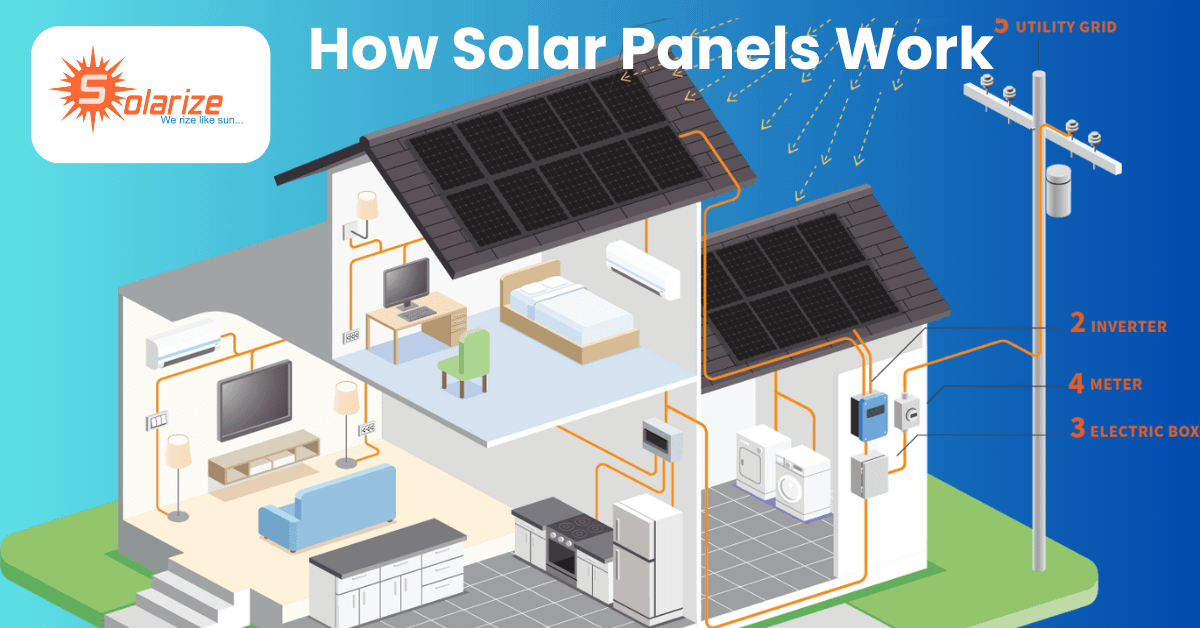An increasing number of homes are looking into solar energy as a feasible alternative due to rising energy bills and growing environmental sustainability consciousness. A common option for cutting electricity costs and carbon footprints is solar panel installation. But comprehending the operation of solar panels can be difficult, particularly for people who are unfamiliar with the idea. We will simplify and make the physics and technology underlying solar panels easily understandable in this blog.
1. What is Solar Panel?
Photovoltaic (PV) panels, also referred to as solar panels, are solar energy conversion devices. They are composed of numerous smaller components known as solar cells, which are usually constructed of the semiconductor silicon. These cells produce electricity when sunlight strikes them and sets off an electric reaction. Typically, these panels are mounted on rooftops or in open spaces to optimise solar radiation exposure.

2. The Science Behind Solar En ergy
A rudimentary understanding of a few scientific concepts is necessary to comprehend how solar panels operate.
Photovoltaic Effect: Solar cells use the photovoltaic effect to turn sunlight into electricity. Photons of sunlight stimulate the electrons in semiconductor material, which is typically silicon, in a solar cell. An electric current is produced when the electrons move as a result of this excitation.
Direct Current (DC) versus Alternating Current (AC): DC electricity is produced by solar panels. On the other hand, alternating current powers the majority of home appliances (AC). An inverter can help in this situation by converting DC to AC power for usage at home.
3. Key Components of System
A standard solar panel system consists of multiple parts that cooperate to produce and supply electricity to your house. These are the essential elements:
Solar panels: They collect solar radiation and use it to generate DC electricity. Layers of silicon cells, metal frames, and glass casings make up the panels.
An inverter is a device that transforms DC electricity generated by solar panels into AC electricity suitable for use by electrical equipment in your home.
The mounting structure is the framework that secures the solar panels at an angle that optimizes sunlight exposure, either on your roof or on the ground.
Battery Storage (Optional): When the solar panels aren’t producing electricity, such as at night or on cloudy days, batteries can be utilised to store extra electricity produced by the panels.
Metering System: A meter keeps track of how much power the home uses and how much is produced by the solar panels. For net metering schemes, in which extra electricity is supplied back into the grid, this is crucial.
4. Step-by-Step: How Solar Generate Electricity
Let’s break down the process of how solar panels convert sunlight into usable electricity step-by-step:
Step 1: Activation of Sunlight
When solar panels are exposed to sunlight, the process starts. When photons from the sun’s rays hit the solar cells in the panels, the semiconductor material (often silicon) releases electrons from their atoms.
Step 2: Producing Direct Current (DC) Power
Electric current flows as a result of the electrons moving around once they are knocked loose. Direct current (DC) electricity is the name given to this type of electrical flow.
Step3:Conversion to Alternating Current (AC) in Step Three
Because domestic equipment run on alternating current (AC), the DC electricity generated by the solar panels cannot be used immediately. To change DC electricity into AC electricity, an inverter is utilised.
Step 4: Energy Distribution to the House
After being converted to AC, the electricity is delivered to the electrical panel in your house, where it is utilised to power appliances, lights, and other electronics. In the event that the solar panels generate more electricity than the house requires, the extra can either be stored in batteries for later use or returned to the grid.
Step 5: Grid Interaction and Net Metering
If the energy produced by your solar panels is greater than what you require, the extra power is put back into the grid. In order to further lower your electricity bill, many utility companies offer net metering programs where you can receive credits for this extra energy.
5. Types of Panels Available for Homeowners
There are several types of solar panels available, each with its unique characteristics. Here’s a quick overview:
Monocrystalline solar panels have a high efficiency and extended lifespan since they are composed of a single, pure crystal structure. They are a well-liked option for homes with small roofs.
Polycrystalline Solar Panels: Despite being less efficient than monocrystalline panels due to their numerous silicon crystal construction, polycrystalline solar panels are still a popular choice for bigger installations due to their lower cost.
One or more thin sheets of photovoltaic material are layered to create thin-film solar panels. Although they are more flexible and lightweight than crystalline panels, they are less efficient.
6. Factors That Affect Solar Panel Efficiency
The effectiveness of solar panels in converting sunlight into electricity is influenced by multiple factors:
Angle and Orientation: The solar panels’ angle and orientation influence the amount of sunlight they receive. In the Northern Hemisphere, panels should preferably face south and be angled at the appropriate angle.
Shade and Obstructions: Solar panels’ effectiveness can be severely lowered by shade from trees, structures, or other obstructions.
Temperature: Colder weather maximises the efficiency of solar panels. They may become less effective in high heat.
Maintenance: To keep the solar panels operating as efficiently as possible, regular maintenance is necessary, including cleaning and inspections.
7. Benefits of Installing Solar Panel for Homeowners
For homeowners, installing solar panels has a number of advantages:
Decreased power Bills: By harnessing the sun’s free energy to generate power, solar panels can drastically reduce your electricity costs.
Environmental Benefits: You can lessen your carbon footprint and help create a more sustainable future by using solar energy, which is clean and renewable.
Enhanced Property Value: Houses with solar panels typically sell for more money and more quickly than those without.
Energy Independence: You become less dependent on the grid and more resistant to rising energy prices if you generate your own electricity.
8. Is Solar Energy Right for You? Key Considerations
Even if solar energy has a lot to offer, you should think about whether it’s the best option for your house. Here are some important things to think about:
Location: Is there plenty of sunlight where your house is located? Solar panels function best in areas with lots of sunlight.
Roof Condition: Is your roof sufficiently spacious to accommodate solar panels, and is it in good condition?
Financial Incentives: Are there any subsidies or grants offered by the federal, state, or local governments for the installation of solar panels?
Initial Investment: Solar panels come with a hefty upfront cost, even if they can save money over time. Think about your funding alternatives and budget.
For homeowners, installing solar panels is an exciting way to lower energy bills, lessen carbon emissions, and raise the value of their homes. To decide if solar energy is the correct choice for you, you must first gain an understanding of how solar panels operate. You can make a big progress towards a more sustainable and energy-efficient future by using the sun’s power.
FAQ
1: How do solar panels generate electricity?
Answer: The photovoltaic (PV) effect is how solar panels produce energy. Sunlight causes electrons in the semiconductor materials used to make the solar cells in the panels—such as silicon—to break free from their atoms. Direct current (DC) electricity is produced by the movement of electrons. The majority of home appliances run on alternating current (AC), which is produced by an inverter and transforms DC electricity.
2.Do solar panels work on cloudy days or during winter?
Answer: Although their effectiveness is decreased, solar panels do function during the winter and on overcast days. Because solar panels need sunlight to function, they will not produce as much energy on overcast days or in situations where there is insufficient sunlight. In diffused light, solar panels can still produce a sizable quantity of electricity, and their efficiency can even increase in colder climates.
3.How long do solar panels last, and do they require maintenance?
Answer: In response, the majority of solar panels have a 25–30 year warranty, and with the right maintenance, they may last even longer. Since solar panels don’t have any moving parts, they require less maintenance. It is normally adequate to perform routine cleaning to remove dust, dirt, and debris, as well as periodic inspections to make sure all components are operating as intended. To get the most out of their solar panel system and extend its longevity, some homeowners choose to hire a professional maintenance company.
4.What happens to excess electricity generated by my solar panels?
Answer: If your solar system is connected to the grid, you can use a technique called net metering to feed any excess electricity your solar panels produce back into the system. Many utility companies offer net metering systems that allow you to receive credits for the extra energy your system generates. When your solar panels aren’t producing enough energy, such at night or on really gloomy days, you can use these credits to reduce your electricity cost.

